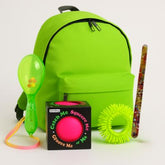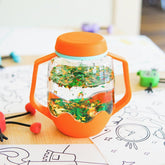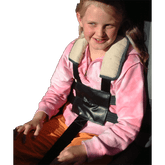Trending Now
Popular Products
Sensory Bundle Back Pack
- £24.99 (£29.99 inc VAT)
- £24.99 (£29.99 inc VAT)
- (-0%)
- Unit price
- / per
Glo Pals Sensory Jar
- £19.49 (£23.39 inc VAT)
- £19.49 (£23.39 inc VAT)
- (-0%)
- Unit price
- / per
-
Purple
-
Blue
-
Yellow
Crelling Model 13 - Rear Fastening Harness
- from £44.99 (£53.99 inc VAT)
- from £44.99 (£53.99 inc VAT)
- (-0%)
- Unit price
- / per
Need Help?
Email Us
- Christmas
- Clothing
- Swim
- Sensory & Activities
- Sensory & Activities
- All Sensory
- Activity Items
- Best Selling
- Guides & Advice
![]()
- Learning
- Daily Living
- Daily Living
- All In The Home
- Best Selling
- In The Home Guides & Support
![]()
- Toileting
- Bedtime
- Out & About
- Teens+
- Condition
- Brands
- Help
- Help
- Help
Back to School: Anxiety Hacks & Tips
New terms, new teachers and changed routines can feel overwhelming. With a clear plan, simple language and a few practical tools, the return to school can be calmer and more predictable for everyone.
Note: Work with your school’s SENCo and class team to agree simple adjustments and communication. This page offers general guidance only.
Parent hacks (anonymous)
Let your child know that lots of other people are anxious about returning to schoool or work too! This will help them know their worries are valid and that they aren't alone in feeling this way.
Give your child the words to describe their feelings. Introduce and explain phrases such as 'back to school blues' and 'the oh no feeling; to help them understand the emotions and feelings behind their back to school anxiety.
Ask them to show how strong their feelings are with TomTags! Children who struggle with language find it easier to show the intensity of their feelings through visual supports.
Show your child how to shrink their bad feelings by thinking of three good reasons why going back to school isn't that bad. They can repeat these reasons out loud whenever they feel anxiety creeping up.
Invest in high quality chew buddies, and fidget kits. They are a safe alternative to anxious habits like biting or scratching. They also help kids concentrate in class and are stimulating for sensory seekers!
Who this can help
- Children and young people who find changes in people, places or routines difficult
- Those who are sensitive to busy corridors, uniform textures or lunchtime crowds
- Families and schools planning first days, new teachers, new classrooms or phased returns
What anxiety can look like
- Body: tummy aches, headaches, faster breathing/heartbeat, tiredness after school
- Behaviour: refusal, clinginess, irritability, mask at school then “after-school crash”
- Thinking: “what if…?”, perfectionism, fear of getting it wrong, worry about new people/places
Quick wins
- Preview, don’t surprise: photos of the classroom, teacher, cloakroom and toilets; a short visit if possible
- One-page profile: “What I like / What helps / What to avoid” — share with all adults
- Micro-routines: same steps for morning, lining up, lunch and home time; same words each day
- Scale the day: use a simple “how worried?” scale (1–5) and agree one helpful action for each number
- One change at a time: introduce one new thing; practise; praise the effort
Before term starts
- Make a photo booklet of key people/places; practise names and routes at home
- Set up a simple visual schedule for mornings and after school
- Prepare a small calm kit (quiet fidget, chew aid, short visual card, timer) and keep it in the bag
- Check uniform comfort (labels, seams, sock textures); agree tolerated alternatives if needed
First days back
- Use a phased build-up if helpful (shorter day, then add blocks)
- Keep arrivals and handovers brief and predictable; same greeting each day
- Agree a help signal (card or gesture) the child can use without leaving their seat
- Offer a quiet check-in on arrival (2–3 minutes) and after lunch
At school: simple supports
- Between lessons: leave 1–2 minutes early to avoid corridor crowds
- Assembly/dining hall: plan seating, shorter duration and a calm “finish” activity
- Unexpected changes: use “first–then” cards with a clear replacement (“first no PE → then library”)
- Recording work: reduce copying; allow shorter answers, scribe, or keyboard where appropriate
After school: reset & routine
- Offer a short reset (drink, snack, 10 minutes quiet play) before homework or clubs
- Use a visual timer for homework and breaks; end on a positive step
- Keep the evening wind-down predictable (same order, low-arousal activity, steady lights)
Schools podcast & webinar (Contact)
Contact has published a top tips for starting school podcast. You can also watch their webinar with Dionne Hollis (Occupational Therapist) and Stephanie Carr (Speech and Language Therapist) on support strategies for managing behaviour and anxiety.
Products that can help
Choose items that match age, setting and sensory profile. (Examples below keep links evergreen.)
- Visual timetables & TomTag planners — make steps obvious and predictable
- Quiet fidgets — hand-busy tools for queues, carpet time and assemblies
- Weighted lap pads — short, supervised use to support calm in class or reading corners
- Visual timers — show “how long” for tasks and breaks
Troubleshooting
- Morning refusal: shrink the first step (to door, to car, to gate); keep a predictable reward on arrival
- Overwhelm at lunch: choose a quieter sitting time/table and a short outside break
- After-school crash: reduce demands; offer snack + quiet time before talking about the day
Funding & budgets
- Potential funding options for families
- Digital catalogues to compare options by category
Need advice?
Email enquiries@fledglings.org.uk with age, key worries (arrival, lunch, home time) and what helps so far. We’ll suggest options that fit your budget. We accept Purchase Orders. UK delivery from £4.99.
Support our work
Donate to Fledglings to help us keep advice free and prices fair.
Related
Last reviewed: 13 September 2025
- Choosing a selection results in a full page refresh.







